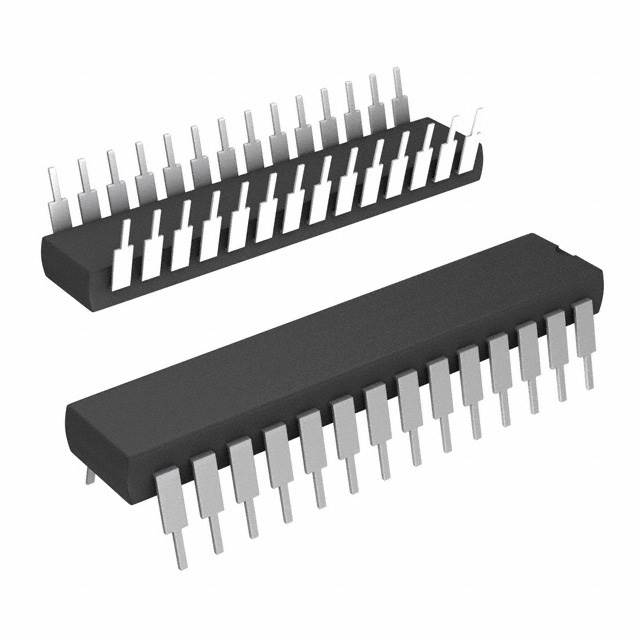Lihat spesifikasi untuk detail produk.

PIC16C63-20E/SP
Introduction
The PIC16C63-20E/SP is a microcontroller belonging to the PIC16C series, which is widely used in embedded systems and electronic devices. This entry provides an overview of the product, including its category, use, characteristics, package, specifications, pin configuration, functional features, advantages, disadvantages, working principles, application field plans, and alternative models.
Basic Information Overview
- Category: Microcontroller
- Use: Embedded systems, electronic devices
- Characteristics: Low power consumption, high performance, versatile I/O capabilities
- Package: 28-pin DIP (Dual Inline Package)
- Essence: Control and process data in embedded systems
- Packaging/Quantity: Single unit packaging
Specifications
- Operating Voltage: 2.5V to 6.0V
- Clock Speed: 20 MHz
- Program Memory Size: 7 KB
- RAM Size: 192 bytes
- I/O Pins: 22
- Timers: 3
- Analog-to-Digital Converter (ADC): 8 channels, 10-bit resolution
Detailed Pin Configuration
The PIC16C63-20E/SP features a 28-pin DIP package with specific pin assignments for power, ground, I/O, and communication interfaces. A detailed pinout diagram can be found in the product datasheet.
Functional Features
- Versatile I/O Capabilities: The microcontroller offers a wide range of digital and analog I/O pins, enabling interfacing with various external devices and sensors.
- Integrated Timers: Three built-in timers provide timing and control functions for applications such as pulse width modulation (PWM) and interval timing.
- Analog-to-Digital Conversion: The integrated ADC allows for the conversion of analog signals into digital values, facilitating sensor interfacing and data acquisition.
Advantages and Disadvantages
Advantages
- Low power consumption
- High clock speed
- Ample program memory size
- Versatile I/O capabilities
Disadvantages
- Limited RAM size
- Lack of advanced communication interfaces (e.g., SPI, I2C)
Working Principles
The PIC16C63-20E/SP operates based on the Harvard architecture, featuring separate program and data memories. It executes instructions fetched from program memory and processes data using its central processing unit (CPU) and peripheral modules.
Detailed Application Field Plans
The PIC16C63-20E/SP is suitable for a wide range of applications, including but not limited to: - Industrial automation - Consumer electronics - Automotive systems - Medical devices - Home appliances
Detailed and Complete Alternative Models
- PIC16F628A: Offers enhanced features such as EEPROM memory and extended I/O capabilities.
- PIC16F877A: Provides higher program memory and RAM sizes, along with advanced communication interfaces.
In conclusion, the PIC16C63-20E/SP microcontroller serves as a versatile and efficient solution for embedded system design, offering a balance of performance and power efficiency. Its wide range of applications and availability of alternative models make it a popular choice among developers and engineers.
Word count: 443
Sebutkan 10 pertanyaan dan jawaban umum terkait penerapan PIC16C63-20E/SP dalam solusi teknis
What is the operating voltage range of PIC16C63-20E/SP?
- The operating voltage range of PIC16C63-20E/SP is 2.5V to 6.0V.What are the key features of PIC16C63-20E/SP?
- Some key features of PIC16C63-20E/SP include 22 I/O pins, 192 bytes of RAM, and 1.75K words of OTP program memory.Can PIC16C63-20E/SP be used in battery-powered applications?
- Yes, PIC16C63-20E/SP's low operating voltage range makes it suitable for battery-powered applications.What communication interfaces does PIC16C63-20E/SP support?
- PIC16C63-20E/SP supports USART and SPI communication interfaces.Is PIC16C63-20E/SP suitable for temperature-sensitive applications?
- Yes, PIC16C63-20E/SP has a wide operating temperature range of -40°C to 125°C, making it suitable for temperature-sensitive applications.Can PIC16C63-20E/SP be programmed using standard programming tools?
- Yes, PIC16C63-20E/SP can be programmed using standard programming tools such as MPLAB® ICD 4 or PICkit™ 4.What are the timer modules available in PIC16C63-20E/SP?
- PIC16C63-20E/SP features two timer modules: Timer0 and Timer1.Does PIC16C63-20E/SP have analog-to-digital conversion capabilities?
- No, PIC16C63-20E/SP does not have built-in analog-to-digital conversion capabilities.Can PIC16C63-20E/SP be used in industrial control applications?
- Yes, PIC16C63-20E/SP's robust design and wide operating temperature range make it suitable for industrial control applications.What development tools are available for PIC16C63-20E/SP?
- Development tools such as MPLAB® X IDE and MPLAB® XC Compilers are available for PIC16C63-20E/SP.

